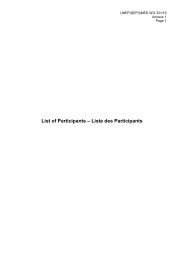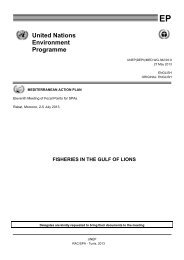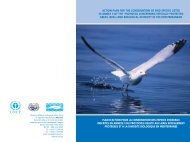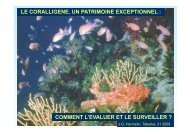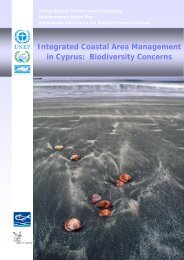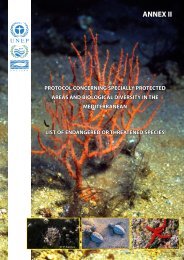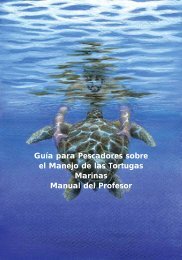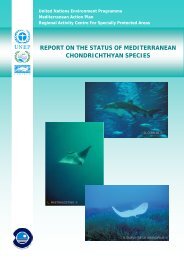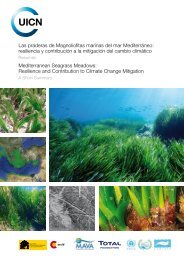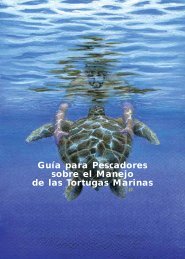Proceedings of the Second Mediterranean Symposium on Marine
Proceedings of the Second Mediterranean Symposium on Marine
Proceedings of the Second Mediterranean Symposium on Marine
Create successful ePaper yourself
Turn your PDF publications into a flip-book with our unique Google optimized e-Paper software.
Gelidiella ramellosa II - - - - 5.7 0.4<br />
Gigartina acicularis II 4.7 5.8 0.2 - - -<br />
Gigartina tedii II - 2.2 - - - -<br />
Gracilaria corallicola II 0.0 1.7 - - - -<br />
G<strong>on</strong>yotrich<strong>on</strong> spp. II 0.7 - - - - -<br />
Griffithsia schousboei II 0.5 0.5 - 0.2 0.3 0.8<br />
Herposiph<strong>on</strong>ia secunda II - - - 0.3 5.3 0.4<br />
Hypnea musciformis II 2.8 0.2 12.8 0.2 - -<br />
Jania rubens I 28.0 2.8 36.5 19.5 20.7 12.9<br />
Laurencia obtusa II 7.7 0.5 9.8 0.7 4.3 1.3<br />
Laurencia papilosa II - - - - - -<br />
Lomentaria clavelosa II 0.2 - - 0.7 9.0 1.3<br />
Lophosiph<strong>on</strong>ia scopulorum II - 2.0 - - - -<br />
Lithothamni<strong>on</strong> spp. I 0.7 - - - 0.3 0.8<br />
Peyss<strong>on</strong>nelia rosa-marina I - - - 0.5 - 4.0<br />
Polysiph<strong>on</strong>ia spp. II 0.3 5.7 2.2 0.3 5.7 0.5<br />
Spermothanmi<strong>on</strong> flabellatum II - - - - 0.5 -<br />
DISCUSSION<br />
The approach to <str<strong>on</strong>g>the</str<strong>on</strong>g> ecological quality status through <str<strong>on</strong>g>the</str<strong>on</strong>g> biotic indices is an old but still<br />
relevant development (Engle et al., 1994; Grall and Glemarec 1997; Borja et al., 2000)<br />
and is based <strong>on</strong> <str<strong>on</strong>g>the</str<strong>on</strong>g> c<strong>on</strong>cept <str<strong>on</strong>g>of</str<strong>on</strong>g> indicator groups (tax<strong>on</strong>omic or functi<strong>on</strong>al) <str<strong>on</strong>g>of</str<strong>on</strong>g> organisms.<br />
Functi<strong>on</strong>al was in some cases preferable than tax<strong>on</strong>omic grouping <str<strong>on</strong>g>of</str<strong>on</strong>g> organisms to<br />
reduce spatial and temporal community variability and to discover patterns without<br />
loosing important informati<strong>on</strong>. For example, a universal pattern described by Regier and<br />
Cowell (1972), Murray and Littler (1978), Sousa (1980), Schramm (1999) and<br />
validated also in this study is that highly stressed or disturbed marine envir<strong>on</strong>ments are<br />
inhabited by annual species with high growth rates and reproductive potential, while<br />
undisturbed marine envir<strong>on</strong>ments by perennial species with low growth rates and<br />
reproductive potential. This was <str<strong>on</strong>g>the</str<strong>on</strong>g> spark to develop <str<strong>on</strong>g>the</str<strong>on</strong>g> biotic index EEI, based <strong>on</strong> <str<strong>on</strong>g>the</str<strong>on</strong>g><br />
functi<strong>on</strong>al-morphological model <str<strong>on</strong>g>of</str<strong>on</strong>g> Littler and Littler (1980) and use it to divide marine<br />
benthic macrophytes in two different ecological groups, <str<strong>on</strong>g>the</str<strong>on</strong>g> late-successi<strong>on</strong>al (perennials,<br />
ESG I) and <str<strong>on</strong>g>the</str<strong>on</strong>g> opportunistic (annuals, ESG II).<br />
In <str<strong>on</strong>g>the</str<strong>on</strong>g> case study <str<strong>on</strong>g>of</str<strong>on</strong>g> Attika coasts, <strong>on</strong> <str<strong>on</strong>g>the</str<strong>on</strong>g> basis <str<strong>on</strong>g>of</str<strong>on</strong>g> <str<strong>on</strong>g>the</str<strong>on</strong>g> EEI <str<strong>on</strong>g>the</str<strong>on</strong>g> sampling stati<strong>on</strong>s were divided<br />
into four classes <str<strong>on</strong>g>of</str<strong>on</strong>g> ES <str<strong>on</strong>g>of</str<strong>on</strong>g> increasing ES in outward directi<strong>on</strong>, which is in accordance to<br />
envir<strong>on</strong>mental c<strong>on</strong>diti<strong>on</strong>s in Sar<strong>on</strong>ikos Gulf (Simboura et al., 1995). Never<str<strong>on</strong>g>the</str<strong>on</strong>g>less, <str<strong>on</strong>g>the</str<strong>on</strong>g><br />
results <str<strong>on</strong>g>of</str<strong>on</strong>g> this study have to be validated by similar studies in o<str<strong>on</strong>g>the</str<strong>on</strong>g>r areas.<br />
ACTES DU DEUXIEME SYMPOSIUM MEDITERRANEEN SUR LA VEGETATION MARINE (ATHENES, 12-13 DECEMBRE 2003)<br />
197



